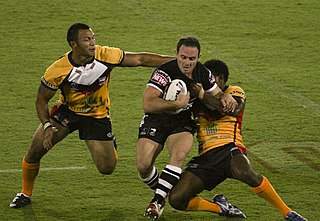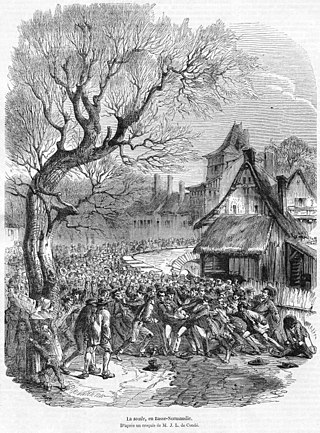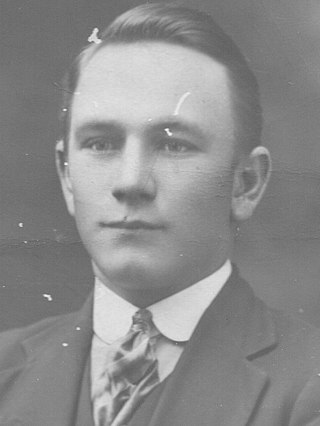
Rugby league football, commonly known as just rugby league and sometimes rugby, football, footy or league, is a full-contact sport played by two teams of thirteen players on a rectangular field measuring 68 m (74 yd) wide and 112–122 m (122–133 yd) long with H shaped posts at both ends. It is one of the two codes of rugby football, the other being rugby union. It originated in 1895 in Huddersfield, Yorkshire, England as the result of a split from the Rugby Football Union (RFU) over the issue of payments to players. The rules of the game governed by the new Northern Rugby Football Union progressively changed from those of the RFU with the specific aim of producing a faster and more entertaining game to appeal to spectators, on whose income the new organisation and its members depended.

The history of rugby union follows from various football games long before the 19th century, but it was not until the middle of that century that the rules were formulated and codified. The code of football later known as rugby union can be traced to three events: the first set of written rules in 1845, the Blackheath Club's decision to leave the Football Association in 1863 and the formation of the Rugby Football Union in 1871. The code was originally known simply as "rugby football". It was not until a schism in 1895, over the payment of players, which resulted in the formation of the separate code of rugby league, that the name "rugby union" was used to differentiate the original rugby code. For most of its history, rugby was a strictly amateur football code, and the sport's administrators frequently imposed bans and restrictions on players who they viewed as professional. It was not until 1995 that rugby union was declared an "open" game, and thus professionalism was sanctioned by the code's governing body, World Rugby—then known as the International Rugby Football Board (IRFB).

The history of rugby league as a separate form of rugby football goes back to 1895 in Huddersfield, West Riding of Yorkshire when the Northern Rugby Football Union broke away from England's established Rugby Football Union to administer its own separate competition. Similar schisms occurred later in Australia and New Zealand in 1907. Gradually the rugby played in these breakaway competitions evolved into a distinctly separate sport that took its name from the professional leagues that administered it. Rugby league in England went on to set attendance and player payment records and rugby league in Australia became the most watched sport on television. The game also developed a significant place in the culture of France, New Zealand and several other Pacific Island nations, such as Papua New Guinea, where it has become the national sport.
A goal from mark is a former scoring move in rugby football. It occurred when a player "marked" the ball by making a fair catch and shouting "mark". From this position, the player could not be tackled. The player then had the option of a free kick, which could be taken as a place-kick, drop-kick, punt, or tap kick. It was possible to score a goal from a place-kick or drop-kick.

Herbert Henry Messenger, nicknamed "Dally" and sometimes "The Master" was one of Australasia's first professional rugby footballers, recognised as one of the greatest-ever players in either code. He played for New South Wales in the first match run by the newly created New South Wales Rugby Football League, which had just split away from the established New South Wales Rugby Football Union.
Ryan Girdler is an Australian former professional rugby league footballer who played in the 1990s and 2000s. A New South Wales State of Origin and Australia international representative goal-kicking centre, he played his club football for the Illawarra Steelers and the Penrith Panthers, winning the 2003 NRL Premiership with the Panthers.
The 2007 All Golds Tour was a tour by the New Zealand national rugby league team, the Kiwis, of Great Britain and France. Conducted as part of the celebrations of a century of rugby league in New Zealand, it was a re-creation of the original New Zealand rugby league tour of Great Britain in 1907. The Kiwis played four test matches, winning one against France, but losing the series against Great Britain 3–0, failing to win the Baskerville Shield. A special game was played between the "All Golds" and the "Northern Union" which featured many players coming out of international retirement for the game. The tour also involved a reception with the Queen at Buckingham Palace for the squad.
Eastern Suburbs District Rugby Football Club competed in their fourth New South Wales Rugby League season in 1911, winning their maiden premiership.
The 1910 season was the 3rd in which the Eastern Suburbs District Rugby League Football Club's competed in the New South Wales Rugby Football League premiership. They finishing the season in 3rd position(out of 8).
The 1909 season was the second in which the Eastern Suburbs DRLFC competed in the New South Wales Rugby Football League competition. They finished the regular season in 4th position, before being knocked out in the semi-final by Balmain.
The 1908 season was the first in the history of the Eastern Suburbs District Rugby League Football Club. Eastern Suburbs competed in the inaugural match of the inaugural season, of the newly formed New South Wales Rugby Football League, reaching the final which they lost to South Sydney. They have the distinction of being the only club to have competed in every season since that time.

Walter Messenger was the youngest son of Charles A. Messenger and Annie. He was an Australian rugby league footballer who played in the 1910s and into the 1920s. He was a state and national representative winger whose club career was played with Eastern Suburbs in the New South Wales Rugby Football League premiership.
The 1908 NSWRFL season was the inaugural season of the New South Wales Rugby Football League's premiership, Australia's first rugby league football club competition, in which nine clubs competed from April till August 1908. The season culminated in the first premiership final, for the Royal Agricultural Society Challenge Shield, which was contested by Eastern Suburbs and South Sydney. In 1908 the NSWRFL also assembled a New South Wales representative team for the first ever interstate series against Queensland, and towards the end of the season, the NSWRFL's leading players were absent, having been selected to go on the first Kangaroo tour of Great Britain.
The 1911 New South Wales Rugby Football League premiership was the fourth season of Sydney’s top-level rugby league club competition, Australia’s first. Eight teams from across the city contested during the season for the premiership and the Royal Agricultural Society Challenge Shield.

The team sports rugby union and rugby league have shared origins and thus many similarities.

A drop goal, field goal, or dropped goal is a method of scoring points in rugby union and rugby league and also, rarely, in American football and Canadian football. A drop goal is scored by drop kicking the ball over the crossbar and between the goalposts. After the kick, the ball must not touch the ground before it goes over and through, although it may touch the crossbar or posts. A drop goal in rugby union is worth three points, and in rugby league a drop goal is usually worth one point.
The 1895–96 Northern Rugby Football Union season was the first ever season of semi-professional rugby football, which formed the foundation of the modern-day sport of rugby league. Twenty-two Northern English teams from both sides of the Pennines broke away from the Rugby Football Union to create and compete in their own competition.

The 1908–09 Kangaroo tour of Great Britain was the first ever such tour for the newly-formed Australia national rugby league team. The tour was to England and Wales and coincided with the first Wallabies Rugby Union tour of Great Britain, which in hindsight put the Kangaroos in a tough position. The game of rugby league was not yet twelve months old in Australia however a New Zealand side had already toured to Britain, Australia had encountered New Zealand during the 1908 season and the pioneer Australian leaders of the game were keen to match up against the Northern Union founders of the code.

The 1907–1908 New Zealand rugby tour of Australia and Great Britain was made by a group of New Zealand rugby footballers who played matches in Australia, Ceylon, England and Wales between 1907 and 1908. Most of the matches were played under the rules of the Northern Union, a sport that is today known as rugby league. As such, the team were the immediate predecessors of the New Zealand national rugby league team. The tour had a large role in establishing rugby league in both Australia and New Zealand, and also gave birth to international rugby league. The tour party has come to be known as the professional All Blacks or All Golds, although at the time they were commonly referred to as the All Blacks—a named popularised by the New Zealand rugby union team that toured the Northern Hemisphere in 1905.
In rugby league football, the Laws of the Game are the rules governing how the sport is played. The Laws are the responsibility of the Rugby League International Federation, and cover the play, officiating, equipment and procedures of the game.









